by angela@diggingbliss | Nov 11, 2006 | Uncategorized

A newly planted succulent bowl with babies from other bowls placed around the perimeter. Succulents root so easily that it’s a shame not to take advantage of that fact. Even a single leaf dropped onto cactus mix will root and grow.
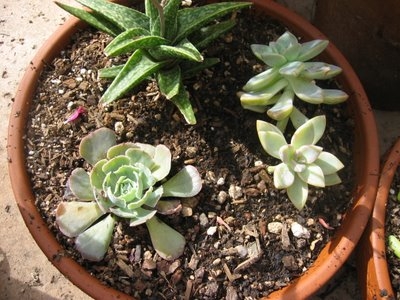
Another new bowl that I’ll fill in with starts from my other bowls.

See the babies, i.e. freebies, near the outer rim?

It’s sasanqua time!

This particular hibiscus has done really well next to the house, under a lath patio cover. It still has buds and flowers since we haven’t experienced any frost or freezes yet.

My citrus has put on a nice flush of growth this fall.
I’ve got my frost-protection cloth ready to go if/when needed.

Still harvesting peppers… that’s made it difficult for me to start my cool-season veggie garden.

Yep, still harvesting tomatoes.

Compact strawberry tree (Arbutus unedo ‘Compacta’) is looking festive
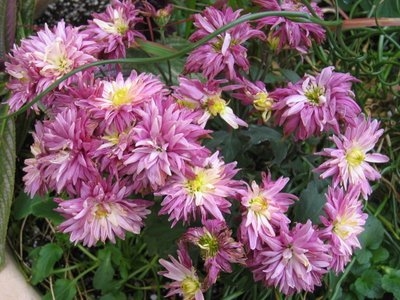
Mums are a great source of color right now.

Blanket of camellia petals and oak leaves on the Santa Barbara daisies… pretty.

Emily is not happy about the shift in the weather.
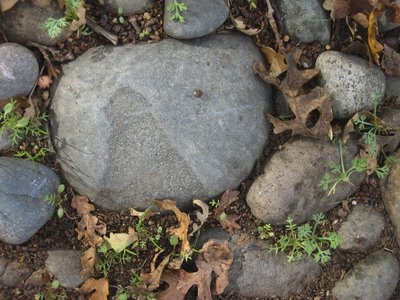
Despite the fact that I didn’t plant any wildflowers this year,
I’m getting good germination from naturally deposited seeds.
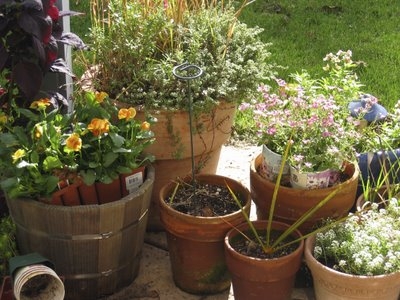
Need to plant seasonal color in tired containers.

Poor man’s orchid (Impatiens balfourii) still blooming

I really like the dark burgundy-brown of the ornamental millet. Adds some drama to the overwhelmingly silver-grey and purple background.

Looking forward to using the firepit.
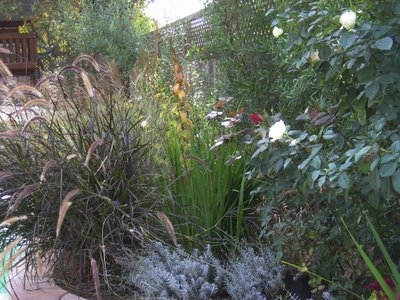
Ornamental grasses really shine in november.
Roses are putting on their last show of the season.

My ‘Eureka’ lemon is looking a little snail bitten, but has put on a lot of growth.

We’ve had our first couple of real rains of the season, so the seat cushions are no longer tied on. They come in and out of the house, depending on the forecast.

‘Medallion’ and ‘JFK’ roses

My mini basil finally took off once the snail activity abated (mostly)

‘Medallion’ up close
 Yes, I need to rejuvenate the chair planter with cool-season plants. This is the “before” picture.
Yes, I need to rejuvenate the chair planter with cool-season plants. This is the “before” picture.

I’m really happy with how nicely this succulent bowl is filling in. The plant in the lower left, commonly called “pork and beans” develops a wonderful blush on the leaf tips and is a great one to share with friends. Roots from a single leaf dropped onto the soil surface.

Slugs and snails are
finally leaving my coleus alone.
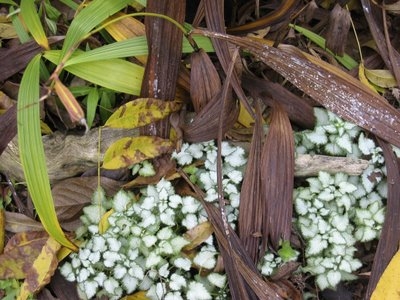 I like the contrast between the decaying green, yellow and brown chinese ground orchid leaves and white lamium.
I like the contrast between the decaying green, yellow and brown chinese ground orchid leaves and white lamium.

Dan loves his new toy, a stuffed duck.

He’s going for the squeaker.

Nasturtiums are still doing their own thing. I started planting them a few years ago and now they happily return on their own.
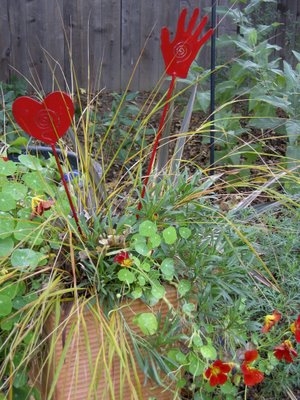

No, this is not marijuana. It’s a water hibiscus I grew from seed.

A baby gunnera leaf.

My salvia leucantha is a big, sprawling beautiful beast right now. My echium is getting big but still hasn’t bloomed and my princess flowers are finally getting bigger and blooming nicely. They got hit pretty hard by frost last year.
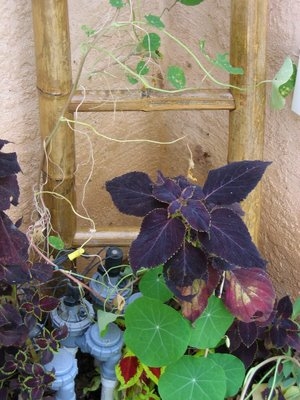
Need a couple more plants to conceal my lovely irrigation system. The nifty bamboo ladder was a $20 score from Emigh Hardware.

I even like the decaying sedum leaves and seedheads.
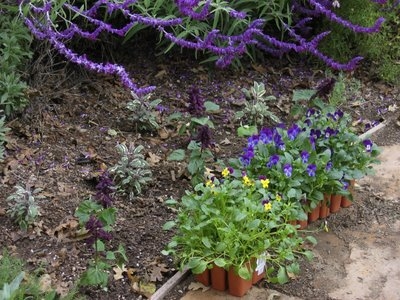 Filling in with a little temporary color while deciding what this spot really wants to be when it grows up
Filling in with a little temporary color while deciding what this spot really wants to be when it grows up
.


TREE DAHLIA BUDS!!!!!

by angela@diggingbliss | Nov 8, 2006 | Uncategorized
Interesting article by Mike Dunne in today’s Taste section of the Bee about local author/farmer Suzanne Ashworth’s farm, Del Rio Botanical, and seed-saving mission–
Multicolored winter squashes carry the seeds of their future
By Mike Dunne – Bee Food Editor
Last Updated 5:56 am PST Wednesday, November 8, 2006
by angela@diggingbliss | Nov 6, 2006 | Uncategorized

If you live in or near Placer County or need an excuse for a day trip, you might be interested in the new 2007 Placer County Harvest calendar. The UC Davis sponsored calendar is full color and lists hours, locations and offerings at the farmer’s market, agriculturual fairs and annual festivals. What a great way to see what’s available each month!
I’d like to see a Placer/Yolo/Sacramento/El Dorado version of this calendar, but Placer County is a great start and hey, they did it first, I presume.
The calendar measures 9″ x 12″ and can be purchased for $13 at the UC Cooperative Extension office, 11477 E Ave., DeWitt Center, Auburn, CA 95603. It’s $15 to have it mailed (includes tax and shipping). Please make checks payable to UC Regents and enclose with order.
This’ll make a great Christmas gift for any local who… well, who eats… or who likes to promote local agriculture, or anyone who wants to venture out on the weekends for a little wholesome fun.
by angela@diggingbliss | Nov 6, 2006 | Uncategorized
Plant them now because it’s been 6 weeks since you stuck them in the fridge.
by angela@diggingbliss | Nov 4, 2006 | Uncategorized
The Garden
Oh, those crazy (and talented!) kids…
by angela@diggingbliss | Nov 4, 2006 | Uncategorized
Californians (and Hawaiians, Idahoans and Arizonans), you have until November 16 to special order fruit trees, vines and shrubs through Dave Wilson Nursery (DWN) and pick them up at local participating nurseries. For the last two years, I’ve missed the deadline and searched local nurseries for particular fruit tree varieties to no avail.
You can check the DWN website to see what your local nursery ordered (a very thoughtful service on DWN’s part, I might add). If they haven’t ordered that succulent pluot or plumcot or cherrot or plapple (ok, the last two were made up) you’ve been fancying to try, you can fill out the special order form, phone, fax or hand-deliver it to your participating nursery, and pick up your order in January-February!
The participating nursery for greater Sacramento is Capital and in El Dorado County it’s The Golden Gecko Garden Center. Elsewhere in California, click here.
 (Photo from Dave Wilson Nursery website)
(Photo from Dave Wilson Nursery website)
Since I ended up ordering three dwarf plums and a cherry through Stark Bros. last year (a great experience, by the way), this year I’m thinking about blueberries. For years, I’ve wanted to try growing them and Dave Wilson Nursery provides a recipe for success, including the right container mix and the fact that the Southern highbush varieties do best in low-chill parts of California. Pretty sure Carmichael is medium chill… around 600-800 hours, but I believe I still want to be looking at low-chill varieties because they tend to be more heat-tolerant. DWN says 500 hours and under is considered low chill.
Nov. 6 update: Foiled again! So, this time I remembered to special order in time, but it turns out blueberries aren’t on the the list! I wonder what BDC (Blueberry Defense Council) will have to say about that… Oh, nevermind.
Guess I’ll have to hit my local nurseries and see which blueberry varieties they carry. Grumble, grumble. I’ll look at mail order too. Still, if you’re looking for fruit trees (apples, plums, peaches, cherries, etc.) or nut trees, try the DWN special order program.
For current and historical chilling data for different parts of California, click here. To give you an idea of how many chilling hours we typically receive, the Fair Oaks weather station recorded a total of 655, 1101 and 647 hours from 1997-1999 and 617, 819, 717, 647, 698 and 1103 between 2001-2005. So all you gotta do is get a ballpark figure for chill hours in your area and then pay attention to the minimum chill hours listed for each variety on the DWN website.
The other Sacramento weather station is at Twitchell Island. Anybody know where that is? Sounds Delta-ish. Hours are measured November 1 through February 28/29 and so far this season, the Fair Oaks station has accumulated, um, 0 hours. Go team! The point is, you can see there’s variability from year to year and judging from the last few years, the Sacramento suburb of Fair Oaks can count on at least 600 hours and some years they’ll even break a thousand. We Sunset Zone 14’ers closer to downtown may not experience quite as much chill.
I’m always a little confused about my burb because Sunset has placed it, in different editions of the Western Garden Book, in both chillier Zone 8 and more temperate Zone 14. With the upcoming edition, who knows? All I do know is that I want it to get cold enough for my plums but not too cold for my citrus. That’s not too much to ask for, is it?
For those of you experiencing California envy, you’ll be happy to know you can buy Dave Wilson Nursery offerings by mail order.
by angela@diggingbliss | Nov 4, 2006 | Uncategorized
Fun stuff!
by angela@diggingbliss | Nov 2, 2006 | Uncategorized
A few years ago, a friend in San Francisco mentioned he had pruned a “10 foot tall tree dahlia.” I shot back in a know-it-all tone, “There’s no such thing as a tree dahlia. That’s insane. It must be some other genus that has dahlia-like flowers.” One tends to become a skeptic after learning the hard way as a budding gardener that there’s no such thing as an “air fern” or a “tree tomato”. A quick flip of the Western Garden Book and I was eating tree dahlia crow. A tree dahlia really is a dahlia. Dahlia imperialis. It can grow to a whopping 12 feet. Who knew? Not even this someone who aced several plant i.d. classes in college.
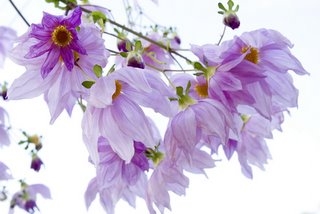
Two years ago, I saw… and touched… and photographed… my first tree dahlias in Mendocino, CA. On a coolness scale of 1 to 10, tree dahlias are a 10. I had to have one.
Last December I put out a query on GardenWeb re: tree dahlia sources and on whether or not anyone grew them in hot-summer, cool-winter Sacramento. Towering tree dahlias, with their striking pink (or white) blooms, are not common in the Sacramento area. In fact, I’ve never seen them for sale at a local nursery and I’ve never seen one growing and about to bloom in a local garden. Until now. In my garden!
A generous gardener from Calistoga offered to swap with me. He got starts of my ‘Tropicanna’ Canna and I got hefty stem cuttings of pink Dahlia imperialis. I was encouraged by the fact that Calistoga gets nearly as hot in the summer as it does here and if this man’s tree dahlias thrived despite summer heat, then they stood a chance in my garden. I found a sheltered spot in the yard where they’d get sun most of the day but would be spared in the late afternoon. Because they were up against the house on the south side, they’d also be protected from strong north winds.
A previous attempt to grow tree dahlias from cuttings shortly before my GardenWeb exchange was a failure. A dear friend and fellow plant addict with the most kick-ass garden on the planet gave me a couple cuttings from her brother via a friend in San Francisco. For some reason, I decided to start my cuttings in my greenhouse, in sand. Not successful. My friend planted her starts in containers using regular potting soil and her tree dahlias are now in their second season and are neck-achingly tall, but with no flowers yet. All I can guess about why hers haven’t bloomed yet is that the cuttings she started with were small compared to the whoppers I got from Calistoga. Or… is it divine justice for all the flowers blooming in her yard that aren’t in mine?
Nah… probably just
Bigger stalk cut closer to the base = more nodes rarin’ to grow
 When I saw buds on my plants, I figured it’d be a good idea to apply some Fox Farm Tiger Bloom
When I saw buds on my plants, I figured it’d be a good idea to apply some Fox Farm Tiger Bloom since I couldn’t remember the last time I fed them. In fact, I probably hadn’t, at all, ever.
since I couldn’t remember the last time I fed them. In fact, I probably hadn’t, at all, ever.
Stem cuttings of tree dahlia resemble bamboo. I was instructed to plant them horizontally in containers. Shoots arise vertically from horizontal nodes on the stems. My plants are still in 5-gallon containers but when it’s time to cut them back in December, I intend to plant the potted tubers in the ground and will stick a few new cuttings in pots in case my soil proves to be too heavy for good in-ground growth.
I hope to be able to share cuttings with friends and family who haven’t yet been invited to join the church of the tree dahlia. I always find myself saying, “This plant is so cool. You have to grow this.” Plant evangelist, yep, that’s me.
If you want to try growing tree dahlias in northern California or beyond, check your local nursery; Kudos to any nursery carrying collector plants like this. You might also try your local dahlia society, and I certainly recommend online plant swapping through GardenWeb’s Plant Exchange or Dave’s Garden! Annie’s Annuals sells the double white form and the pink form, by the way. In fact, tree dahlias might not be considered such a big deal in the bay area and other parts of the coast. Still… a dahlia… up to 12 feet tall? Dang!
Just came across the following link while doing a search for photos of the stalks. It’s an ebay dealer in San Francisco that sells all kinds of strange wonderful things, including Dahlia imperialis. Hey, guess what the business name is? StrangeWonderfulThings.com. They have a great photo of the base of a mature tree dahlia plant. Also, they say a tree dahlia can reach twenty feet! OMG.
Ok, here’s the official Sunset Western Garden Book entry on D. imperialis–
D. imperialis. TREE DAHLIA. Zones 4-6, 8, 9, 14-24. Multistemmed tree grows each year from permanent roots to a possible 10-20 ft. tall, 4-6 ft. wide. Daisylike, 4-8-in.-wide lavender flowers with yellow centers bloom at branch ends in late fall. Leaves divided into many leaflets. Frost kills tops completely; cut back to ground afterward. If tree dahlia were longer blooming or evergreen, it would be a valued landscape plant, but anual dieback relegates it to tall novelty class. Available from specialists; seldom sold in nurseries. Grow from cuttings taken near stem tops (or from side shoots) in fall; root in containers of moist sand kept in a protected place over winter. Or dig root clump and divide in fall. Give full sun or partial shade. D. excelsa, D. maxonii are similar.
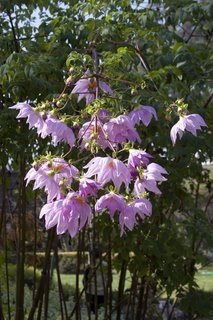
by angela@diggingbliss | Nov 1, 2006 | Uncategorized

What? Angela doesn’t only read gardening books? Ooh, she’s so multi-dimensional.
Nature Noir is a great read, folks, and is northern California and nature-related so I can justify recommending it on my Northern California nature lovin’ garden blog. This book will make you want to hug a park ranger.
This particular park ranger, Jordan Fisher Smith, writes with a lyricism and level of compassion I don’t think many of us could muster after spending years guarding a river facing damnation, finding tree-studded hills dotted not only with native wildflowers but with modern-day armed outlaws, and having pastoral moments snatched away by bureaucracy and the random call of the dispatcher.
To be a park ranger: Must enjoy life and death, guns and flowers, boredom and terror, paperwork and budget cuts, beauty and ugliness, rafting and hiking, solitude and brotherhood.
—————-
NPR Interview with Jordan Fisher Smith
by angela@diggingbliss | Oct 31, 2006 | Uncategorized
Photo by Mike Posehn

Garden bloggers, check out this super-cool interactive panorama shot of a garden in Loomis, CA. It’s called
Loomis Labyrinth. Mike Posehn of
Granite Bay Software made the photograph. His website,
Dog’s Leap, offers panorama prints. Mike’s panorama images are also part of U.C. Berkeley’s
Worldwide Panorama Project.
Granite Bay Software also sells a program called GBTimelapse for creating time-lapse video clips from still images and it’s compatible with most Canon PowerShot and EOS digital cameras. Mike’s timelapse clips can be purchased here.
You can even download the GB Timelapse free trial before buying the software for $49. Imagine the flower and garden applications for this software— showing flowers bursting into bloom, showing how sunrise and sunset wash over your garden. You might even be able to show your garden going from unpruned to pruned! Click here to see if the software works with your Canon camera. Mike even tells you how you can sell your own timelapse clips through TimeLapse Digital.
 A newly planted succulent bowl with babies from other bowls placed around the perimeter. Succulents root so easily that it’s a shame not to take advantage of that fact. Even a single leaf dropped onto cactus mix will root and grow.
A newly planted succulent bowl with babies from other bowls placed around the perimeter. Succulents root so easily that it’s a shame not to take advantage of that fact. Even a single leaf dropped onto cactus mix will root and grow.
 This particular hibiscus has done really well next to the house, under a lath patio cover. It still has buds and flowers since we haven’t experienced any frost or freezes yet.
This particular hibiscus has done really well next to the house, under a lath patio cover. It still has buds and flowers since we haven’t experienced any frost or freezes yet.
 My citrus has put on a nice flush of growth this fall.
My citrus has put on a nice flush of growth this fall. Despite the fact that I didn’t plant any wildflowers this year,
Despite the fact that I didn’t plant any wildflowers this year, I really like the dark burgundy-brown of the ornamental millet. Adds some drama to the overwhelmingly silver-grey and purple background.
I really like the dark burgundy-brown of the ornamental millet. Adds some drama to the overwhelmingly silver-grey and purple background.
 We’ve had our first couple of real rains of the season, so the seat cushions are no longer tied on. They come in and out of the house, depending on the forecast.
We’ve had our first couple of real rains of the season, so the seat cushions are no longer tied on. They come in and out of the house, depending on the forecast.
 Yes, I need to rejuvenate the chair planter with cool-season plants. This is the “before” picture.
Yes, I need to rejuvenate the chair planter with cool-season plants. This is the “before” picture. I’m really happy with how nicely this succulent bowl is filling in. The plant in the lower left, commonly called “pork and beans” develops a wonderful blush on the leaf tips and is a great one to share with friends. Roots from a single leaf dropped onto the soil surface.
I’m really happy with how nicely this succulent bowl is filling in. The plant in the lower left, commonly called “pork and beans” develops a wonderful blush on the leaf tips and is a great one to share with friends. Roots from a single leaf dropped onto the soil surface.
 I like the contrast between the decaying green, yellow and brown chinese ground orchid leaves and white lamium.
I like the contrast between the decaying green, yellow and brown chinese ground orchid leaves and white lamium. Nasturtiums are still doing their own thing. I started planting them a few years ago and now they happily return on their own.
Nasturtiums are still doing their own thing. I started planting them a few years ago and now they happily return on their own.
 My salvia leucantha is a big, sprawling beautiful beast right now. My echium is getting big but still hasn’t bloomed and my princess flowers are finally getting bigger and blooming nicely. They got hit pretty hard by frost last year.
My salvia leucantha is a big, sprawling beautiful beast right now. My echium is getting big but still hasn’t bloomed and my princess flowers are finally getting bigger and blooming nicely. They got hit pretty hard by frost last year.
 Need a couple more plants to conceal my lovely irrigation system. The nifty bamboo ladder was a $20 score from Emigh Hardware.
Need a couple more plants to conceal my lovely irrigation system. The nifty bamboo ladder was a $20 score from Emigh Hardware.
 Filling in with a little temporary color while deciding what this spot really wants to be when it grows up
Filling in with a little temporary color while deciding what this spot really wants to be when it grows up




































